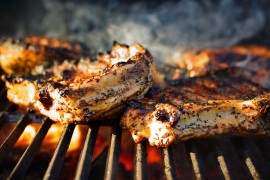Heat damages the delicate nutrients and enzymes in food, as well as its subtle yet all-important energy field.
It begins its demolition job on all of these – and in many cases finishes it – at a fraction of the temperature at which most food is cooked.
In addition, heat causes the formation of substances which can damage our cells when they come into contact with them – and as these substances are not naturally occurring they can be hard for our bodies to detoxify, so add to our toxic load.
Do you see the double whammy at play here? Heat damages essential disease-protective nutrients in food and causes the formation of disease-producing ones.
Cooked foods give the body more work to do in digesting and detoxifying them, but also give it much less in terms of the raw materials (literally) it needs to do this.
As raw food fans, we know all this, but where we err, in my opinion, is that we often think of “cooked” and “raw” the same way we think of “black” and “white”.
However, when you start to look into food, temperature and biochemistry you quickly realise that when it comes to the foods most people (including health-conscious raw food fans) really eat, the terms “raw” and “cooked” don’t actually tell us that much about a lot of what goes down the hatch.
We need to know more. First of all, has the food in question been heated, and if so for how long and to what temperature?
If you’re like most raw food fans, you eat both cooked and raw foods, and you want to make the very best choices in both. My goal in sharing this information is to help you do just that.
So rather than thinking of food as simply “raw” or “cooked”, I have identified six different categories according to both temperature and duration of heating.
Here’s a hint: dehydrated foods are not in the first category – the raw one. They are in the second category, as they are heated, often for 12 hours or more, and therefore fundamentally different.
That said, the gap between raw and dehydrated is not as great as the gap between dehydrated foods and even the most lightly cooked cooked foods.
I call the most cooked category of all “cremated”. Why? Because foods in this category are not just cooked, in many cases at very high temperatures. By the time you eat them they have been high-temperature cooked two, three times or more!
As you’ll discover, this last category is not only populated by junk foods, but by many choices that are generally thought of as “health foods”.
Here are the six stages from “raw” to “cremated”:
- Raw
- Low-temperature heated
- Lightly cooked
- Medium cooked
- High temperature cooked
- Cremated
Of course, the above is, in reality, a continuum, but I’ve chunked it into categories to simplify it.
As food is heated, different biochemical changes kick in at different temperatures. When we heat food to only 105F (40C), we avoid most of those changes, which is why the raw community generally agrees this food can still be classed as raw.
Steamed fresh, organic vegetables are a great choice, but let’s not kid ourselves that just because we only steam them for a couple of minutes, and they’re still crunchy, they’re basically raw.
That’s because they’ll have been heated to over 200F and once you go above 150F (66C), the specific cellular damage that occurs at each given temperature generally occurs within seconds, rather than minutes, of the food reaching that temperature, and is irreversible. Move just a little further up the temperature scale, and the damage associated with any given temperature occurs in a fraction of a second.
If you were to put your hand into boiling water (or the steam rising off it, and not immediately pull it out), your skin would suffer a burn. That burn is basically cellular damage, and food cooked at this temperature suffers the same degree of cellular damage, as quickly; it just isn’t as obvious.
So let’s move up the temperature scale, starting with…
1. Raw food – 72F (22C)
100% unheated, truly raw food, at room temperature. All those changes us raw food fans recognise are best avoided – the cellular changes heat causes which, in simple terms, always come down to the food in question giving us less of what we need and more of what we don’t? We only avoid those undesirable changes completely when we choose food that is really, truly raw. And to put it bluntly, that means eatin’ without heatin’, folks.
2. Low temperature heated food – up to 118F (48C)
“Raw” dehydrated food is generally heated at 100-118F (38-48C) for anything from a couple of hours to 36 hours. Let’s call a spade a spade here: dehydration is a form of very low temperature cooking. Within the raw community it’s fairly widely accepted that food can be heated to up to 105 degrees Fahrenheit and still be classed as raw, and some put the figure as high as 118F (48C).
Nobody credible is suggesting that food heated to above 120F (48C) should be called raw, and some experts maintain that the word raw should be used only for food that truly is – i.e. food that has not been heated at all. Though I don’t eat 100% raw, I have to declare myself in that camp. I just think it helps us make better choices when we’re clear there’s a difference between truly raw foods and foods which have been heated, even at low temperatures.
The cut-off point is where it is, i.e. in the early 100s Fahrenheit, because at temperatures much higher than this enzymes in food start to be deactivated, and at 130 they are all dead within minutes. However, the 105-118F (40-48C) range is an arbitrary cut-off point as enzymes are just one important component of our food.
For example, at 110F (43C) two essential amino acids, lysine and tryptophan, start to be destroyed.
Soup gently warmed in the dehydrator at 105F/40C is closer to raw than apple slices dehydrated at 110 for eight hours, which is closer to raw than agave syrup heated to 120 for 36 hours, as some raw-labelled agave syrup on the market is. Clearly, none of these choices are raw when compared to a vital, alive, water-rich apple but they are still a lot less cooked than…
3. Lightly cooked food – 200-212F (93-100C)
This category includes foods that are steamed, poached and boiled. It may not take longer than 10-15 minutes to cook your veggies this way, and maybe even just five. If you cook them for just five they’ll still be very crunchy when you eat them, but your skin, subjected to this temperature, would suffer a third-degree burn in just one second.
Water-based cooking methods are the healthiest of all. At the lightly cooked level of heating you can prepare veggies in an endless array of different ways. Steaming is better than boiling, but if you choose to boil, try to consume the water, too, to get (what’s left of) the nutrients in it. You can stir “fry” vegetables at this temperature if you “fry” then in water rather than oil. Use oil and the temperature jumps to at least 350F (176C) and category 5. If you’re cooking fish and can poach it, that’s much better than grilling or sautéing, both of which will take it to at least 350F (176C).
4. Medium-cooked food – 200-390F (93-200C)
Example: Slow-cooked soups or stews, which can be cooked at “lightly cooked” temperatures, but make it into this category as they’re cooked for so much longer – often an hour or more. And at the higher-heat end of this category: some of the lower oven cooking temperatures.
5. High-temperature-cooked food – fried food, and food heated to above 390F (200C)
Fried and deep fried food is generally heated to between 350 and 375F (176 and 190C) for anything from 2 minutes to 12 minutes. Exposing fats to high heat is known to result in the formation of numerous damaging substances, including carcinogens. Baked foods are generally cooked at 390-450F (200-232C) for up to two hours or more in the case of baked potatoes. A roast chicken will be cooked at 400F (204C) for two hours.
6. Cremated food – food that’s been cooked, cooked and cooked again
“Healthy” packaged granola
This generally uses cooked oats, cooked olive oil, cooked sweetener (maple syrup, honey etc) cooked added sugar, and cooked (“dried”) fruit. I’m talking about the basic ingredients here, that the manufacturer buys in in order to make the granola (or that you buy if making it at home). The oil and sweeteners will be melted together at temperatures of around 350F, the other ingredients mixed in (second cooking), and then the granola is cooked at around 300F (148C) for 45 minutes (the third).
Pasta
The best-case scenario here: you eat or make fresh pasta, so the wheat in the pasta has only been twice cooked – when it’s processed into flour, and again when you cooked the pasta. But if you eat dried pasta out of a packet, on the other hand, make that thrice cooked – the pasta was made with cooked flour, cooked again in order to dry the pasta for long shelf life, and when you make supper you’re cooking it for its third time. Pop a pasta ready meal in the microwave (or rather, don’t) and you’ll be cooking ingredients in it for their fourth of fifth time.
Baked goods
Loaves are generally baked for 20-30 minutes at 390-450F (200-232C). Bagels, rolls and smaller loaves may be cooked at around 425F (218C) for just 10-15 minutes, and cookies for around the same. But remember, in all cases the flour has been cooked previously.
Other than the cookies, those are some of the healthier choices in this category, relatively speaking. Roast potatoes – perhaps the most cooked home-cooked food of all — are generally boiled for several minutes prior to being cooked for an hour, in fat, at 500F (260C).
Perhaps the most cooked restaurant food of all is food deep-fried in fast food joints (and other places not to eat at) where cheap oil is likely to be reheated over and over and over all day long (and in some really gnarly joints, for even longer) before being changed. This oil will be loaded with toxins and trans fats and about as natural a substance for your body to break down as eating plastic would be.
My goal in sharing this information is to encourage you to eat more raw foods, and when eating cooked, to focus on foods in categories 3 and 4, and go easy on those in 5 and 6.






Thank you for putting this article together. I eat around 50% raw and much of the cooked food I eat, I eat out (or out of packets). This information motivates me to make time to prepare more of my own foods.
View CommentI have been a vegan for more than two decades already but I used to cook the veggies I eat. The raw foods I eat are mostly fruits. I am enlightened by this article in terms of my food intake. Thanks a bunch, Sarah.
View Comment